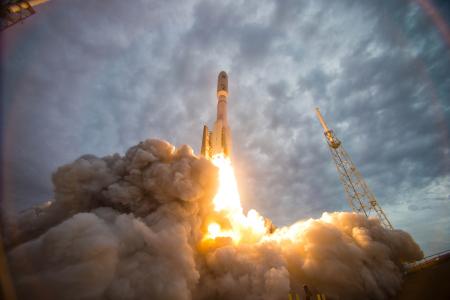
U.S. Funds Development of Russian Rocket Engine Replacement
Brendan McGarry

U.S. lawmakers have agreed to fund the development of an American-made replacement to the Russian engine used on some military rockets.
The massive spending bill, called the Omnibus Appropriations Act, which Congress may vote on today, would avert a government shutdown and fund most federal agencies for the rest of the year, including the Defense Department.
The legislation would provide $220 million “to accelerate rocket propulsion system development,” according to the bill’s accompany text, which clearly targets the Russian-made RD-180 even though it doesn’t specify the propulsion system.
The RD-180, made by NPO Energomash, is used as a first-stage engine on the Atlas V booster in the Air Force’s Evolved Expendable Launch Vehicle program. United Launch Alliance LLC, a joint venture of Lockheed Martin Corp. and Boeing Co., is sole supplier of the acquisition effort, which launches military and spy satellites into space.
While the engine is relatively cheap and has contributed to ULA’s long record of successful launches, it has become a flash point in the debate over American reliance on Russian technology for national-security programs, particularly after tensions grew between the U.S. and Russia over the latter’s military involvement this year in the Ukraine.
The engine has also been cited by such companies as Space Exploration Technologies Corp., known as SpaceX and headed by billionaire Elon Musk, as reason to open more EELV launches to competition from American commercial space firms.
The additional funding, however, may benefit other companies, such as Aerojet Rocketdyne, which has partnered with Huntsville, Alabama-based Dynetics, to design a new rocket engine called the AR-1, a liquid oxygen and kerosene-fueled propulsion system that’s similar to the iconic Apollo-era F1.
The companies have pitched the AR-1 as a possible candidate for both NASA and Pentagon rockets, including the Atlas made by Lockheed, the Antares made by Orbital Sciences Corp. and eventually NASA’s Space Launch System, which is slated to use solid rocket engines left over from the space shuttle program but may transition to LOX-kerosene systems in the future.
If the Air Force decides to move forward with a similar risk-reduction and technology development program as NASA, an AR-1 prototype could be ready in 2–1/2 years and an operational engine could be in place by 2019, company officials have said.
That time line is similar to the legislative language, which specifies a “target demonstration date of fiscal year 2019.”
The bill would direct Air Force Secretary Deborah Lee James and NASA Administrator Charles Bolden “to develop an affordable, innovative, and competitive strategy for this development effort that includes an assessment of the potential benefits and challenges of using public-private partnerships, innovative teaming arrangements, and small business considerations.”
It states, “The strategy should include plans for targeted risk reduction projects and technology maturation efforts to buy down risk and accelerate potential launch system solutions,” and calls for the document to be submitted to the congressional defense committees within six months.
